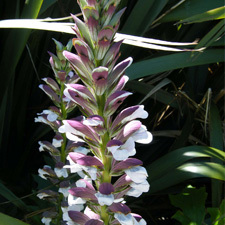 Bears breeches
Bears breeches
Common name: Bears breeches
Botanical name: Acanthus mollis
Management programme: Advisory
Originally from Europe, it was introduced to New Zealand as an ornamental species and was recorded as naturalised in 1958.
Why is it a pest?
- Forms dense large clumps and spreads rapidly in disturbed ground covering large areas.
- Shades out native plants in shady environments.
- Spread by water and birds so can disperse large distances.
Where is it found?
Preferred habitat is shady areas of river banks and roadsides, also pasture.
What does it look like?
- Leafy, erect perennial herb with thick roots and large, glossy, strongly lobed dark green leaves on long stalks.
- Numerous partly tubular flowers (from October to April) with one white petal and a large purple ‘hood’, with purple or brownish veins, are held at the top of the stem in a spike. Flowers mature from the bottom first.
- Many dark brown, flattened oval seeds, are produced in individual capsules from November to May.
What are the rules?
Advisory
Council does not enforce the control of advisory species. It is landowner/ occupier responsibility to manage these pests. Council may provide advice on how to manage or control advisory species if required.
How do you get rid of it?
- Dig-out (all year) – dispose of all roots and seed heads at transfer stations. Leaves can be mulched.
- Cut and paste (all year)
CAUTION: When using any herbicide or pesticide, PLEASE READ THE LABEL THOROUGHLY to ensure that all instructions and directions for the purchase, use and storage of the product, are followed and adhered to.
Read more on pest control advice, information and regulations.
Images





